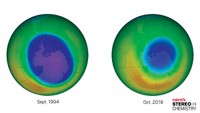Advertisement
Grab your lab coat. Let's get started
Welcome!
Welcome!
Create an account below to get 6 C&EN articles per month, receive newsletters and more - all free.
It seems this is your first time logging in online. Please enter the following information to continue.
As an ACS member you automatically get access to this site. All we need is few more details to create your reading experience.
Not you? Sign in with a different account.
Not you? Sign in with a different account.
ERROR 1
ERROR 1
ERROR 2
ERROR 2
ERROR 2
ERROR 2
ERROR 2
Password and Confirm password must match.
If you have an ACS member number, please enter it here so we can link this account to your membership. (optional)
ERROR 2
ACS values your privacy. By submitting your information, you are gaining access to C&EN and subscribing to our weekly newsletter. We use the information you provide to make your reading experience better, and we will never sell your data to third party members.
Environment
Unfinished Business
by Pamela S. Zurer, Deputy editor-in-chief
January 22, 2007
| A version of this story appeared in
Volume 85, Issue 4
THIS IS THE LAST ISSUE of C&EN I'll have a hand in, as I'm retiring after 26 years with the magazine. I will miss being part of the recurring miracle of getting this newsmagazine out each week.
Science journalists have the greatest job in the world. We are paid to learn new things by talking to intelligent, interesting people doing fascinating, important work. We then face the intellectual challenge of putting what we've learned in perspective and conveying it clearly. As I've cleaned out my files, I've been remembering all the great times I've had courtesy of C&EN, from scrambling around an active volcano with a geochemist to sharing a podium with a chemistry Nobel Laureate.
I've also been struck, however, by how many of the contentious topics I've written about over the years are far from resolved.
Take the numbers and status of women in chemistry, for instance. Three letters to the editor published in our last issue point to the depressing fact that only a single woman was among the 18 winners of the prestigious Division of Organic Chemistry fellowships for 2005-06. C&EN has chronicled some movement on this front, but women remain sorely underrepresented in far too many sectors of the chemistry community. Ten years ago, I wrote an essay entitled "Where Are The Women?" that I could just as well have written today.
Food irradiation is another example. Also in the last issue, Senior Editor Bette Hileman described renewed interest in the process sparked by the recent rash of fatal food poisonings. In 1986, I wrote a cover story addressing the same issues of quality control and public acceptance of the technology.
A Baltimore Orioles fan since my days in grad school at Johns Hopkins during the late 1970s, I was thrilled to hear on Jan. 9 that the great Cal Ripken Jr. had been elected to baseball's Hall of Fame. But I was troubled that many accounts led with the news of the rejection of slugger Mark McGwire, whose reputation has been tarred by his suspected steroid use. The uncomfortable role of performance-enhancing drugs in sports is a topic I first wrote about in 1984. Senior Editor Steve Ritter continues to cover that beat, most recently tackling the scandal surrounding 2006 Tour de France winner Floyd Landis.
Misconduct in research is another complex issue the scientific community has yet to fully come to grips with. Although chemists like to think such unethical behavior is rare in our discipline, News Editor William Schulz reported on a couple of troubling cases in the past year and is digging into yet another. As I wrote in 1996, "The real question is not how often scientific misconduct occurs, or whether the scientific record is ultimately self-correcting. It is how the community behaves when faced with unpleasant allegations against one of it established members."
Nuclear waste disposal. Crack cocaine addiction. Asbestos hazards. These topics, too, were subjects of cover stories I wrote during my C&EN career that have yet to be adequately dealt with by society. But the piece of unfinished business that most troubles me is our failure to address the reality of global change brought about by our profligate production of greenhouse gases.
In 1986, I was part of a team led by Senior Correspondent Lois Ember that put together a C&EN special issue on the changing atmosphere. Over the next 15 years, I wrote more than 100 related articles, mostly on ozone depletion, the international consensus to control the chlorofluorocarbon culprits, and the ultimately successful search for CFC substitutes.
The discovery of the Antarctic ozone hole, I believe, was the shock that galvanized public opinion to do something about ozone depletion. I fear some sort of similar "smoking gun" evidence of injury to our planet is needed to stimulate the political will to address climate change. Maybe the vanishing Arctic summer icepack and the plight of the polar bears will prove to be the tipping point.
In my new role as C&EN subscriber, rather than C&EN insider, I'll look forward to reading about how chemists are helping to solve the problem.
Views expressed on this page are those of the author and not necessarily those of ACS.



Join the conversation
Contact the reporter
Submit a Letter to the Editor for publication
Engage with us on Twitter